How Too Cook Melt in Your Mouth Beef Roast
Need an easy roast beef recipe for a Sunday roast or special occasion? This easy recipe will produce the juiciest and most tender roast beef , with minimal effort! Follow our tips and tricks for the best results every time.
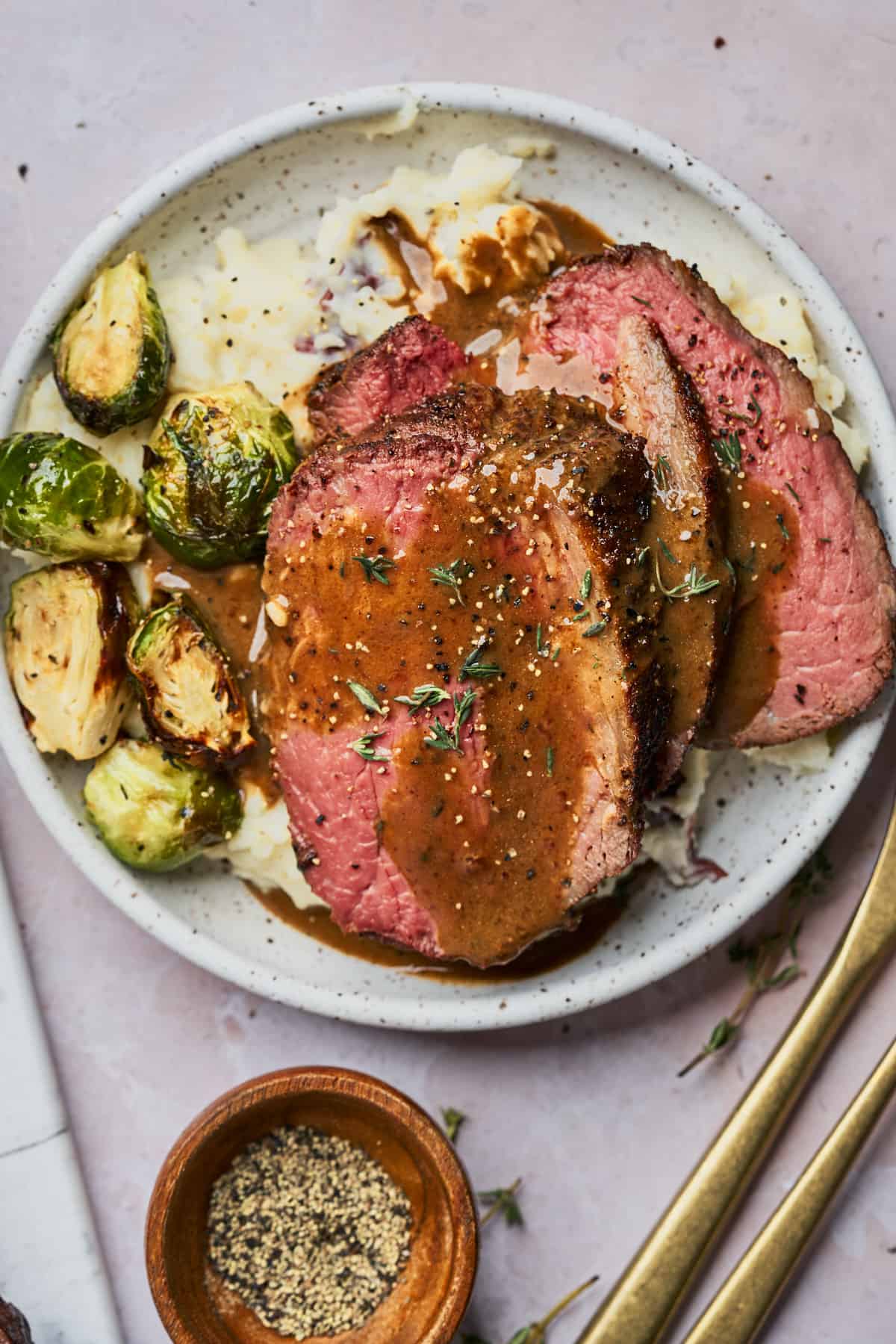
No matter the occasion, this roast beef can be a show stopper every time. Slow cooking beef for a while makes for an incredibly delicious and hearty meal. Home cooks rejoice, we have you covered with the best recipe for deliciously flavorful and tender roast beef!
If you're looking for more beef recipes for a special occasion, be sure to check out this creamy steak and seafood skillet, these delicious Swedish meatballs, or this delightful steak appetizer with blue cheese, bacon, and sweet potatoes!
Jump to:
- ❤️Why you'll love this
- 🐂Ingredients
- ✏️Ingredient Notes
- 📖Instructions
- ✨Tips & tricks
- 💭Frequently asked questions
- ✨Substitutions
- 🥔What to serve with roast beef
- ♨️temperature guide
- 🛒Shop this post
- 🥣Storage & reheating
- 🌟Leave a review!
- 📖 Recipe
❤️Why you'll love this
- Simple ingredients: This recipe calls for everyday cuts of meat, pantry staples, and seasonings. Anything you don't have can be found at nearly any grocery store.
- Serve a crowd: If you're cooking for multiple people, you're going to love this recipe. Everyone will have perfectly seasoned, tender and juicy roast beef on their plate. Save yourself time and effort by making a large serving that everyone can have.
- Minimal effort: This roast comes together in a couple of simple steps. Start by seasoning it well, then searing it in a hot skillet to seal in the juices, then roast. While this roast does need some time in the oven to get tender, that also means you can work on other things while you wait for the roast. Finally, take the pan drippings while the roast rests to make the perfect gravy. It comes out amazing every time!
🐂Ingredients
Here are the ingredients you will need. Please note, that the seasonings can be adjusted to suit your taste.
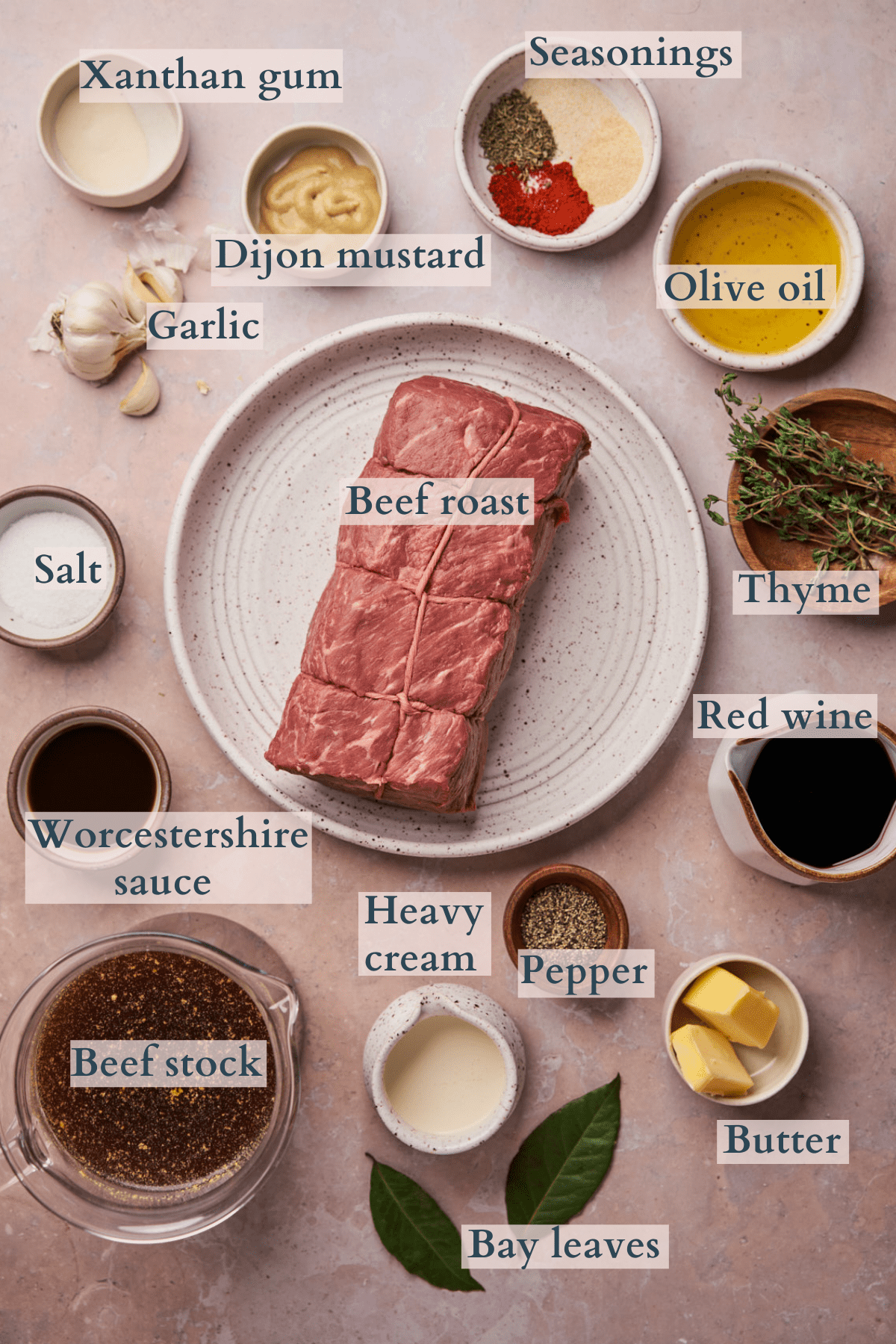
✏️Ingredient Notes
Please see the recipe card for quantities and nutritional information.
- Beef roast - Use your favorite cut of meat here. We used a bottom-round roast.
- Garlic cloves - Fresh garlic is going to be the best. We add whole cloves to the braising liquid and discard them before finishing the gravy to infuse lots of flavor.
- Beef broth or stock & red wine - To create a very flavorful braising liquid that will be transformed into an awesome brown gravy at the end.
- Butter and olive oil - We use both. We start with olive oil to get a nice sear on the beef roast. Butter is added later on to create the gravy.
- Seasonings - We use a simple blend of kosher salt, black pepper, garlic powder, onion powder, smoked paprika, and dried thyme for this roast. Feel free to add in any other seasonings you like. The blend we use is very flavorful, but still neutral enough to go with all of your favorite sides!
- Fresh thyme - To add to the braising liquid for flavor and to garnish later.
- Bay leaves
- Worcestershire sauce - To infuse tons of savory flavor into the gravy.
- Dijon mustard - Adds a bit of zing to the gravy.
- Heavy cream - To make the gravy ever-so-slightly creamy, and give the gravy a beautiful shine.
- Xanthan gum - Or any other thickener of choice like flour, arrowroot powder, or cornstarch.
📖Instructions
🔪Prep work
- Preheat the oven to 250°F.
- Peel garlic cloves.
- Measure out stock, wine, seasonings, and herbs.
- Dry the roast really well with paper towel to make sure it's completely dry before seasoning it.
Season the roast
In a small bowl, combine most of the salt, and pepper. Then add in all the garlic powder, onion powder, smoked paprika, and thyme. Season the roast really well on all sides. Reserve a bit of salt and pepper for later.


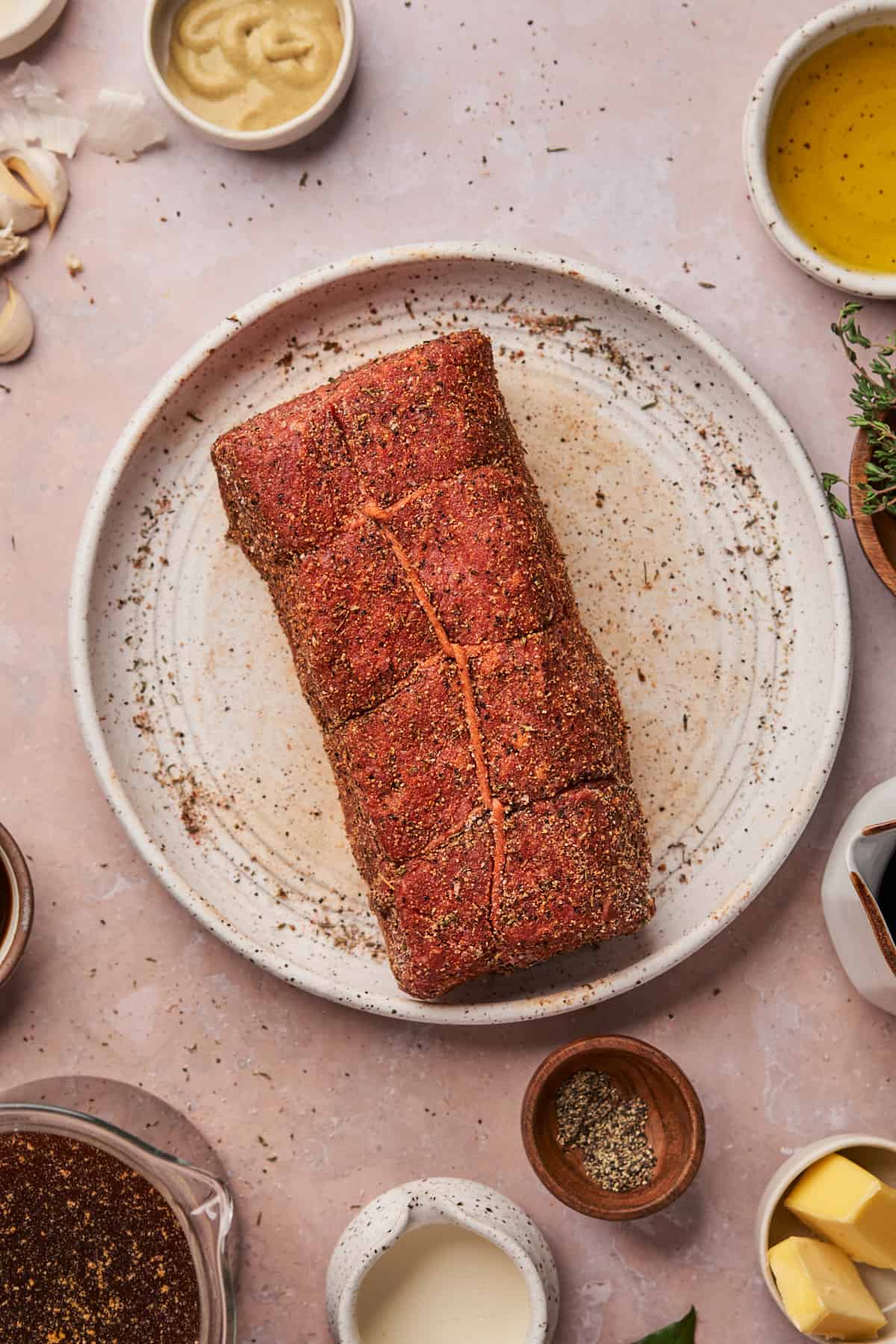
Sear the roast
Heat a cast iron skillet or large dutch oven over medium high heat. Add the olive oil, and sear roast on all sides until brown. This will take roughly 10 minutes, then transfer meat to a plate.
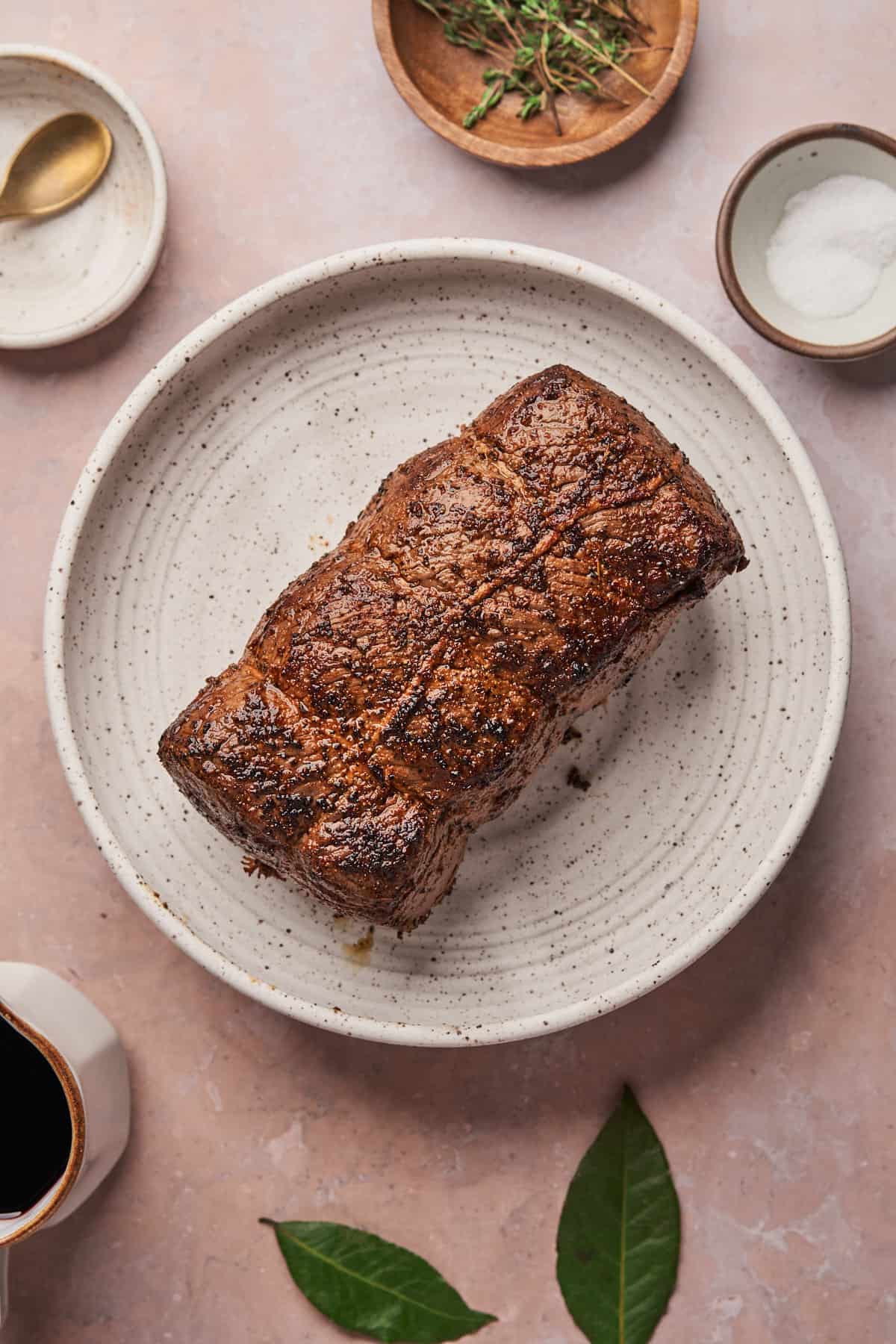
Prepare the braising liquid
To the skillet, deglaze it by adding about half (2 cups) of beef broth and red wine and scrape the bottom of the pan with a wooden spoon. Then add the beef back to the pan.
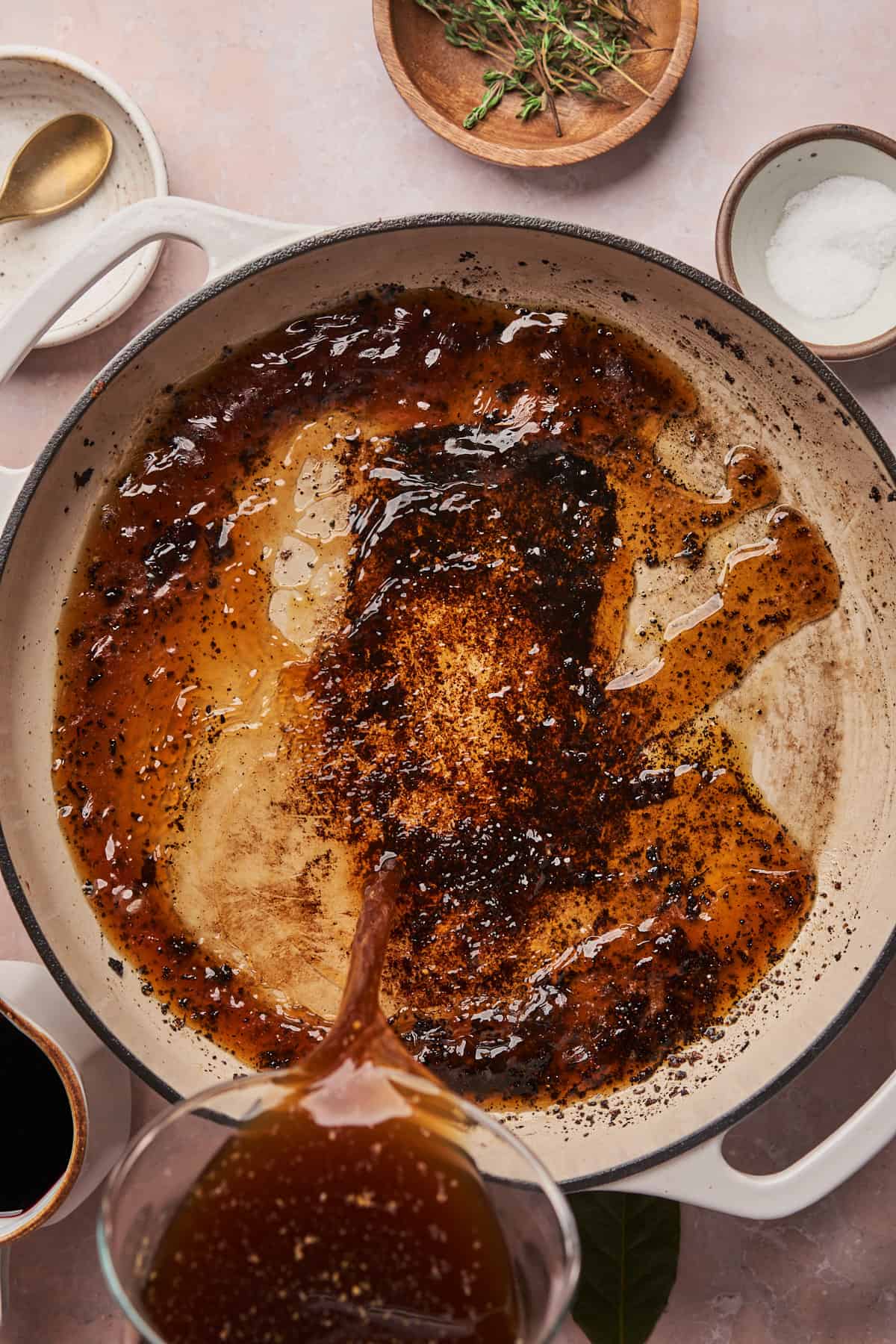
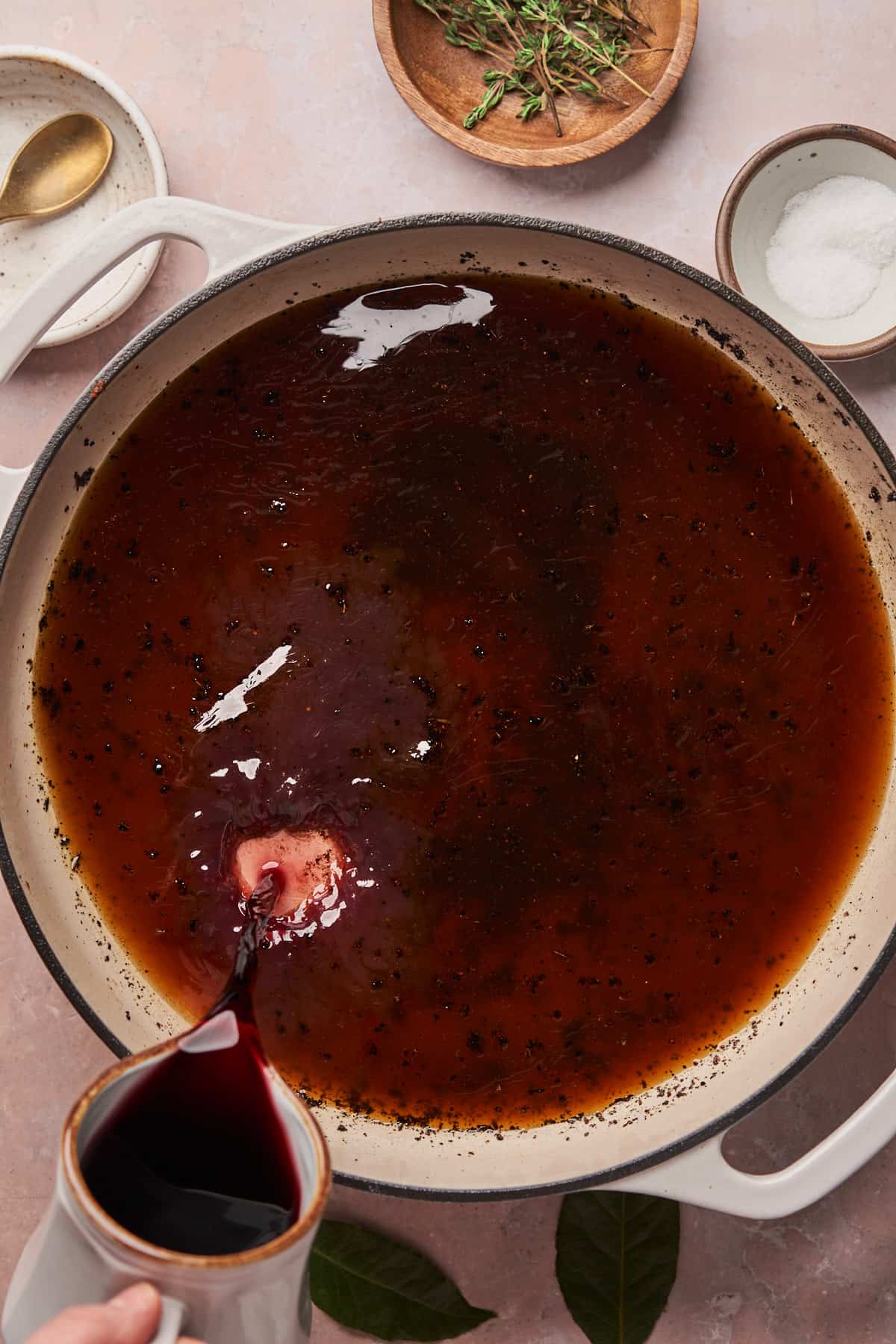
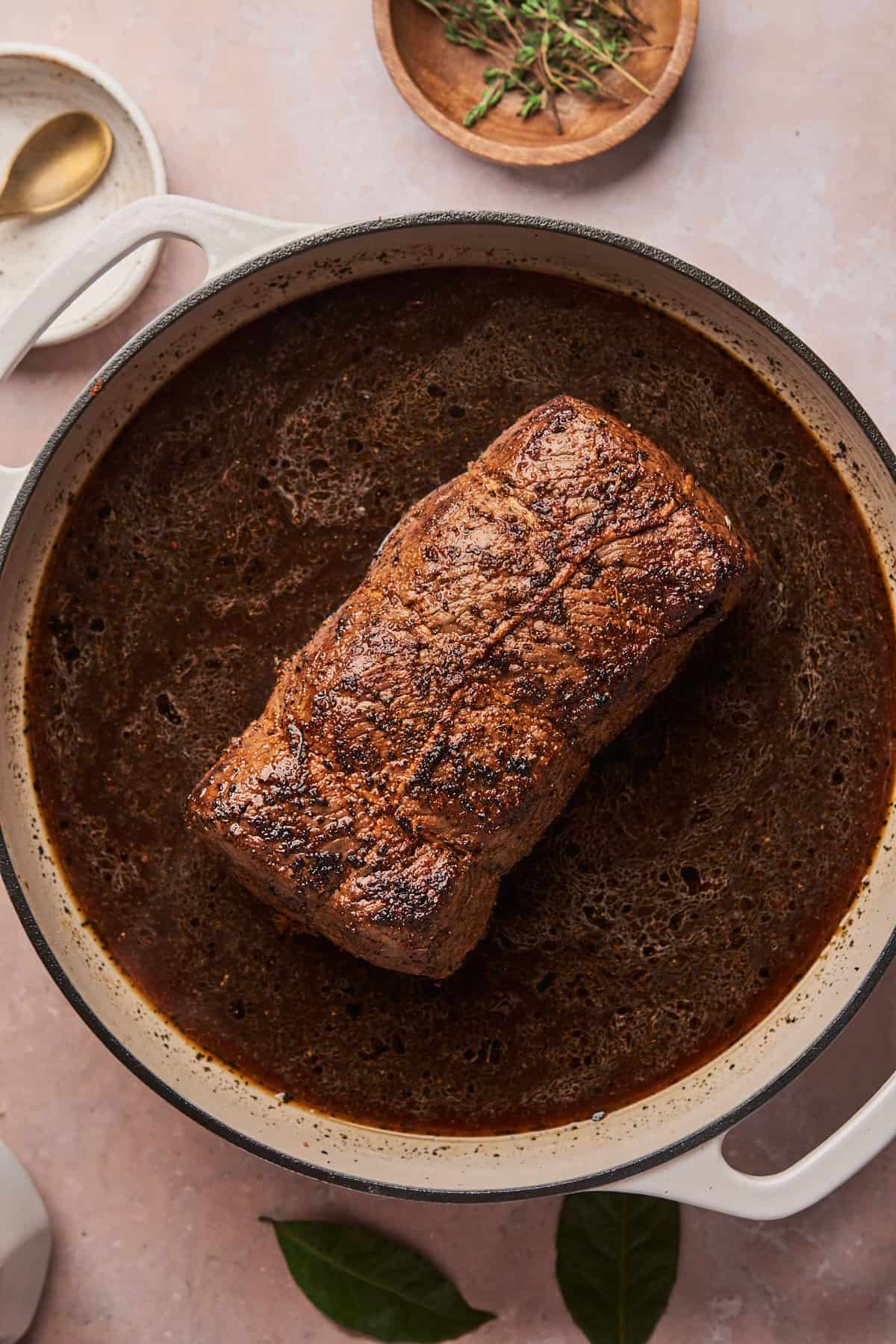
Add in garlic cloves, bay leaves, and thyme sprigs.
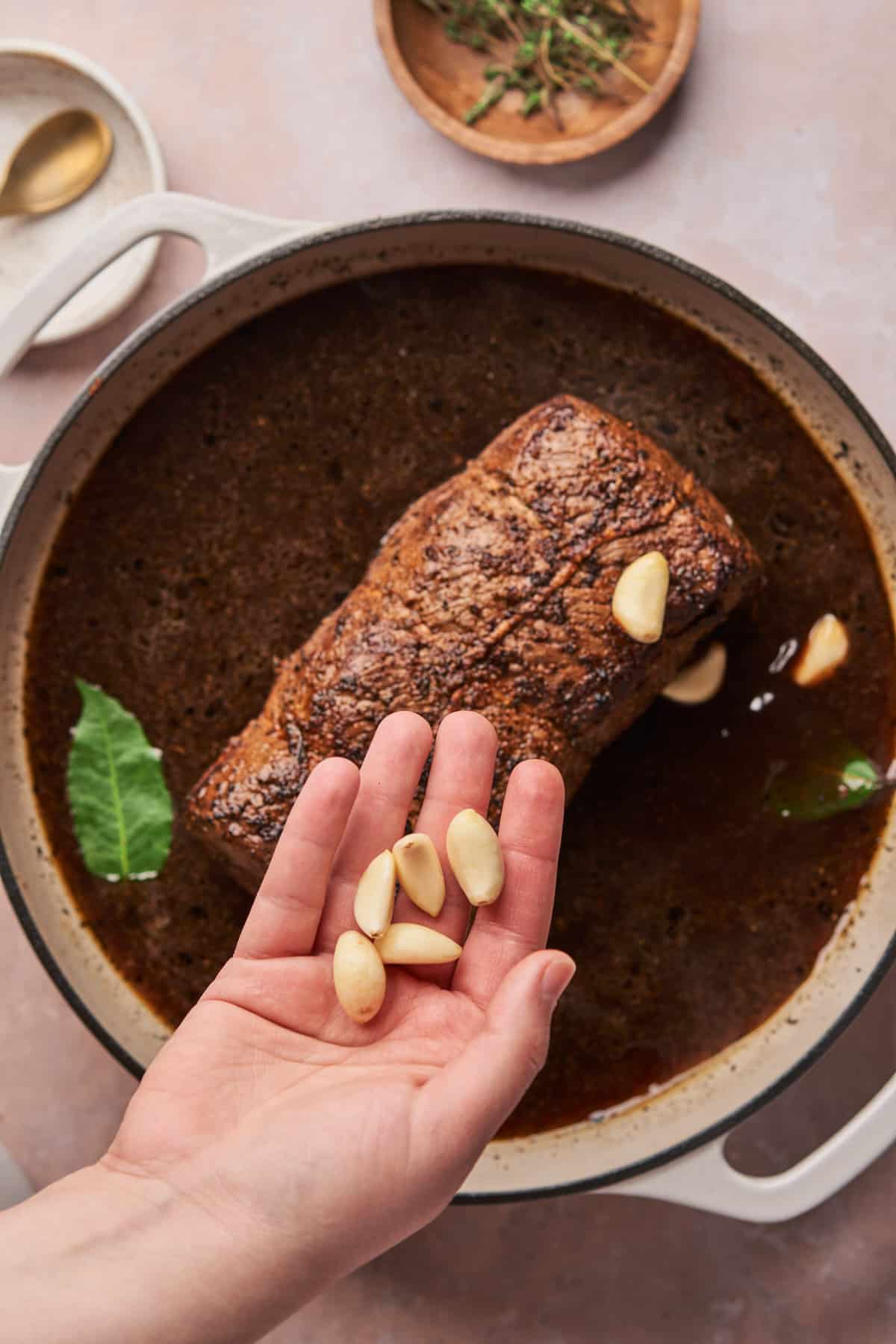
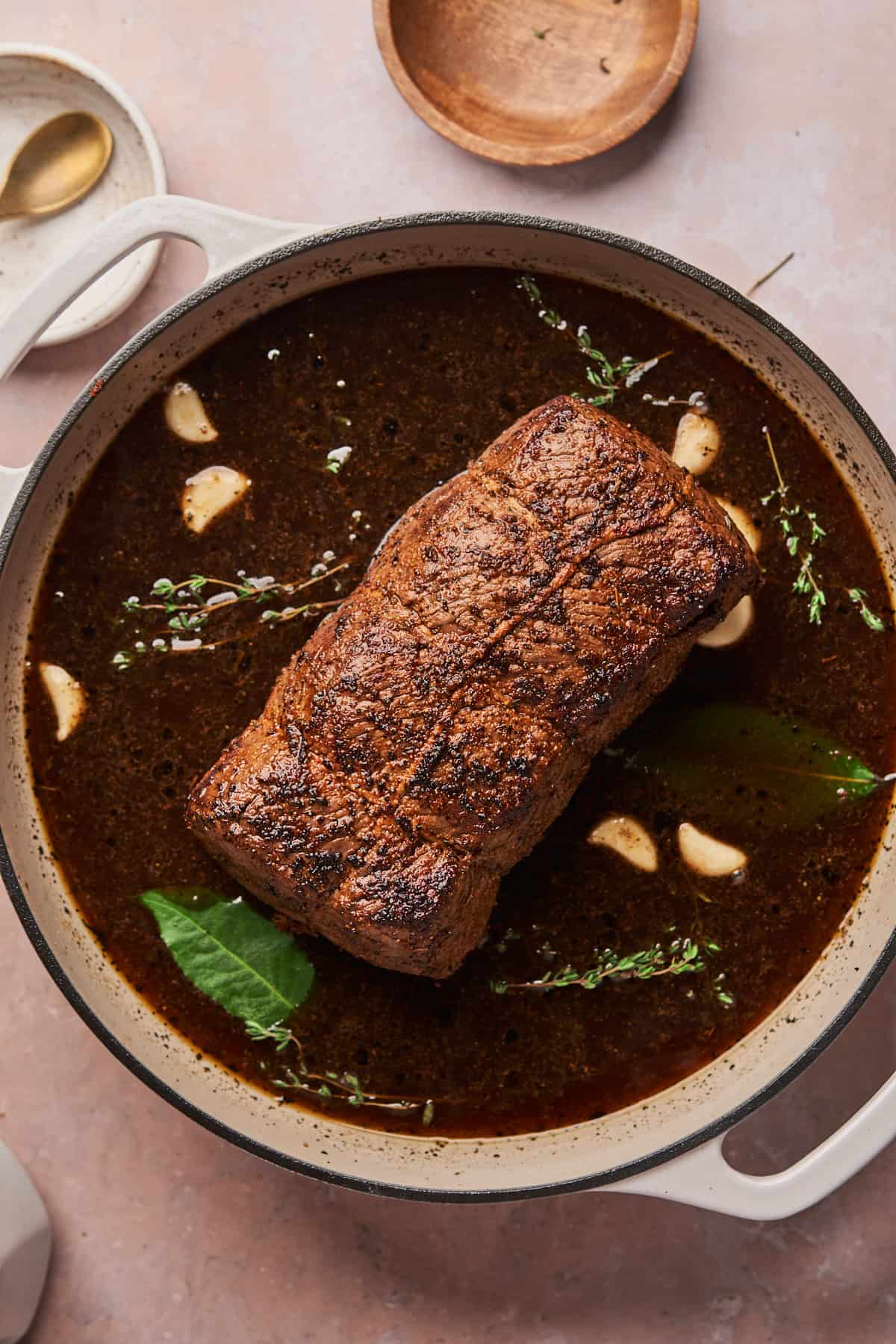
Roast the beef
Add to the oven with a meat thermometer and let it cook uncovered until the temperature reaches between 115°F to 120°F. This can vary a lot depending on the size of your roast, which is why we recommend a meat thermometer. For us, this took about 1 hour and 15 minutes.
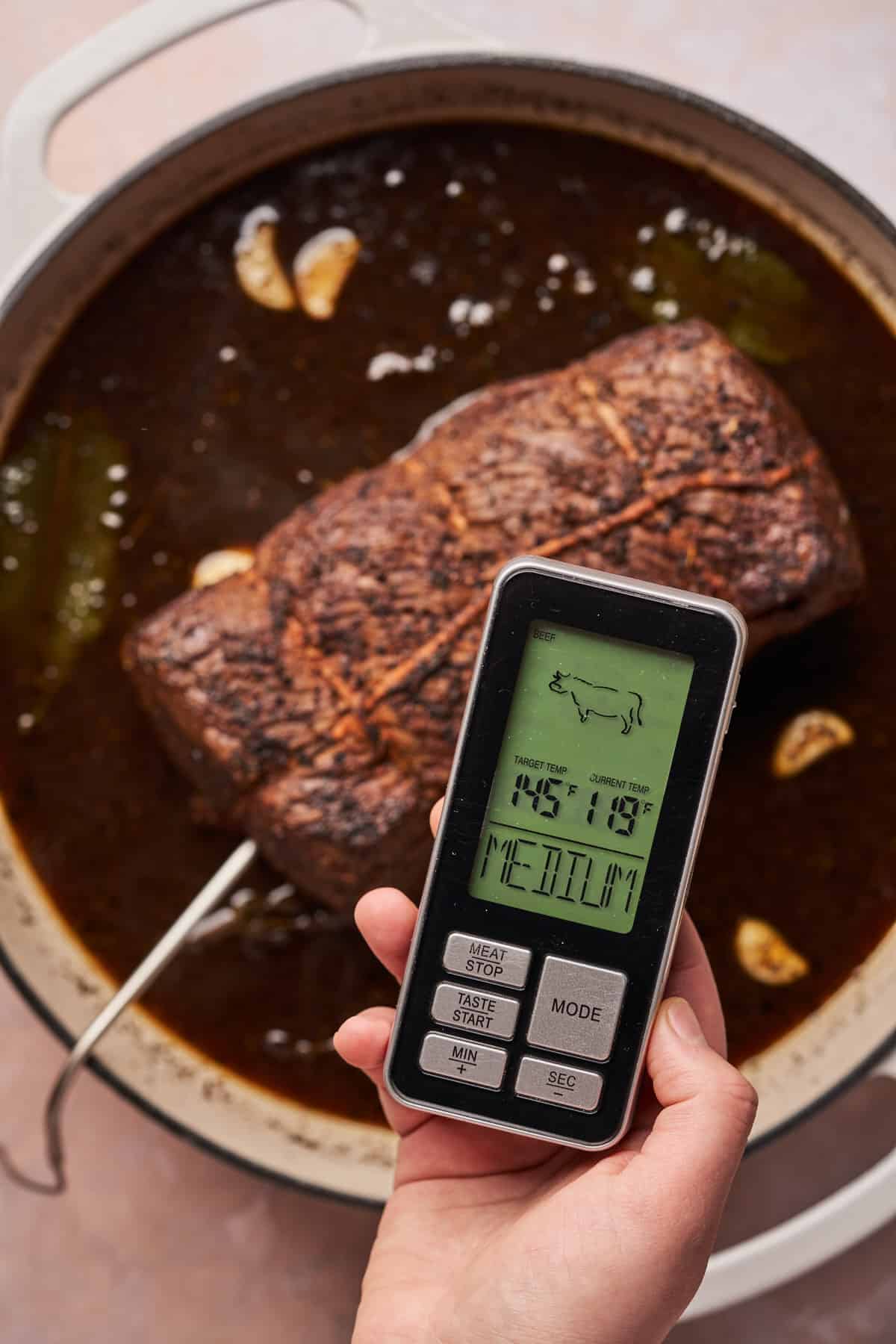
Tent the beef and rest
Remove the roast from the pan, set it on a plate, and tent the roast with foil. Leave the thermometer inside to monitor the temperature. Allow the roast to rest tented for at least 15-20 minutes. This will ensure all of the juices stay locked in.
You will want the roast to reach between 120°F - 130°F for rare to medium rare before serving just depending on your preference.
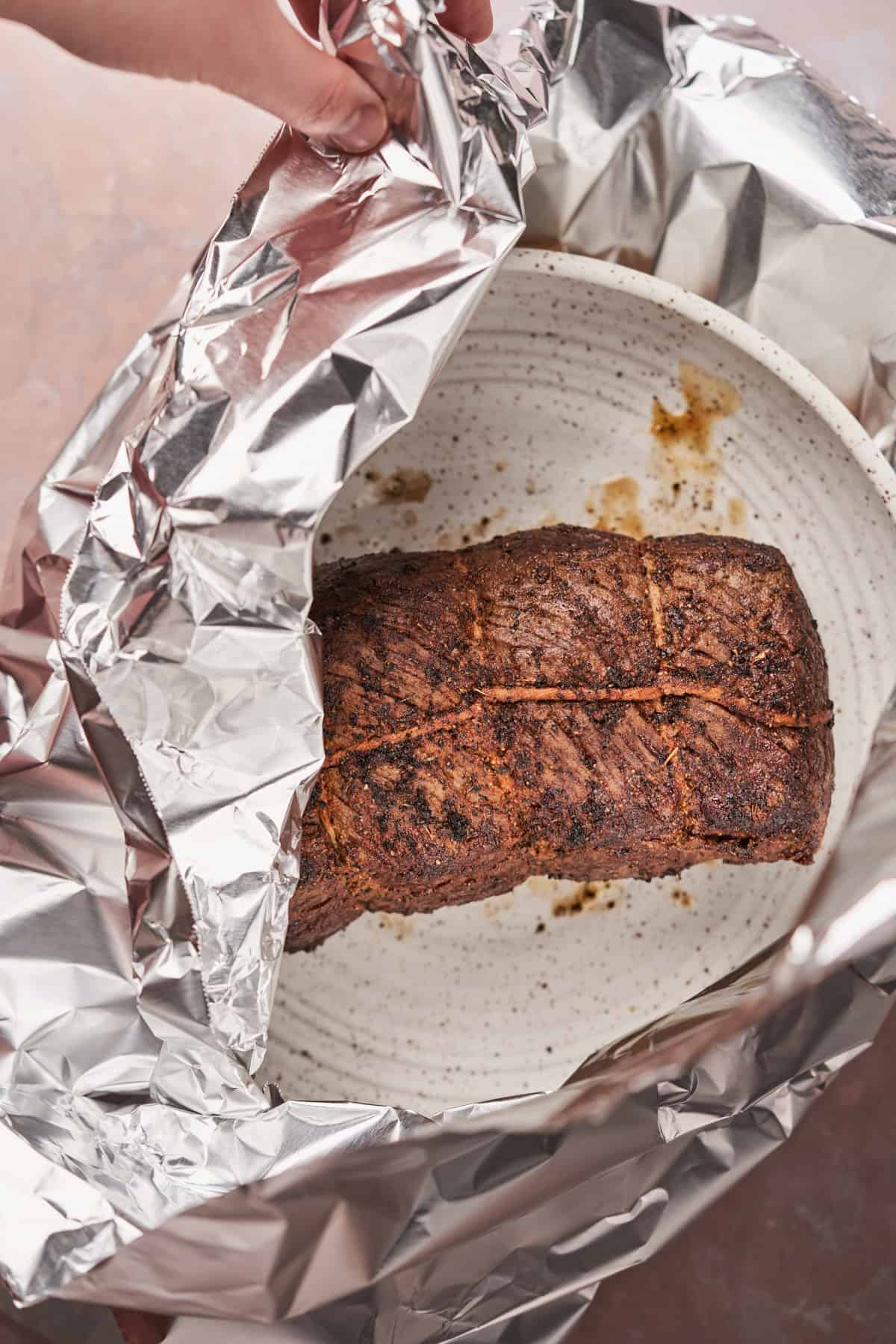
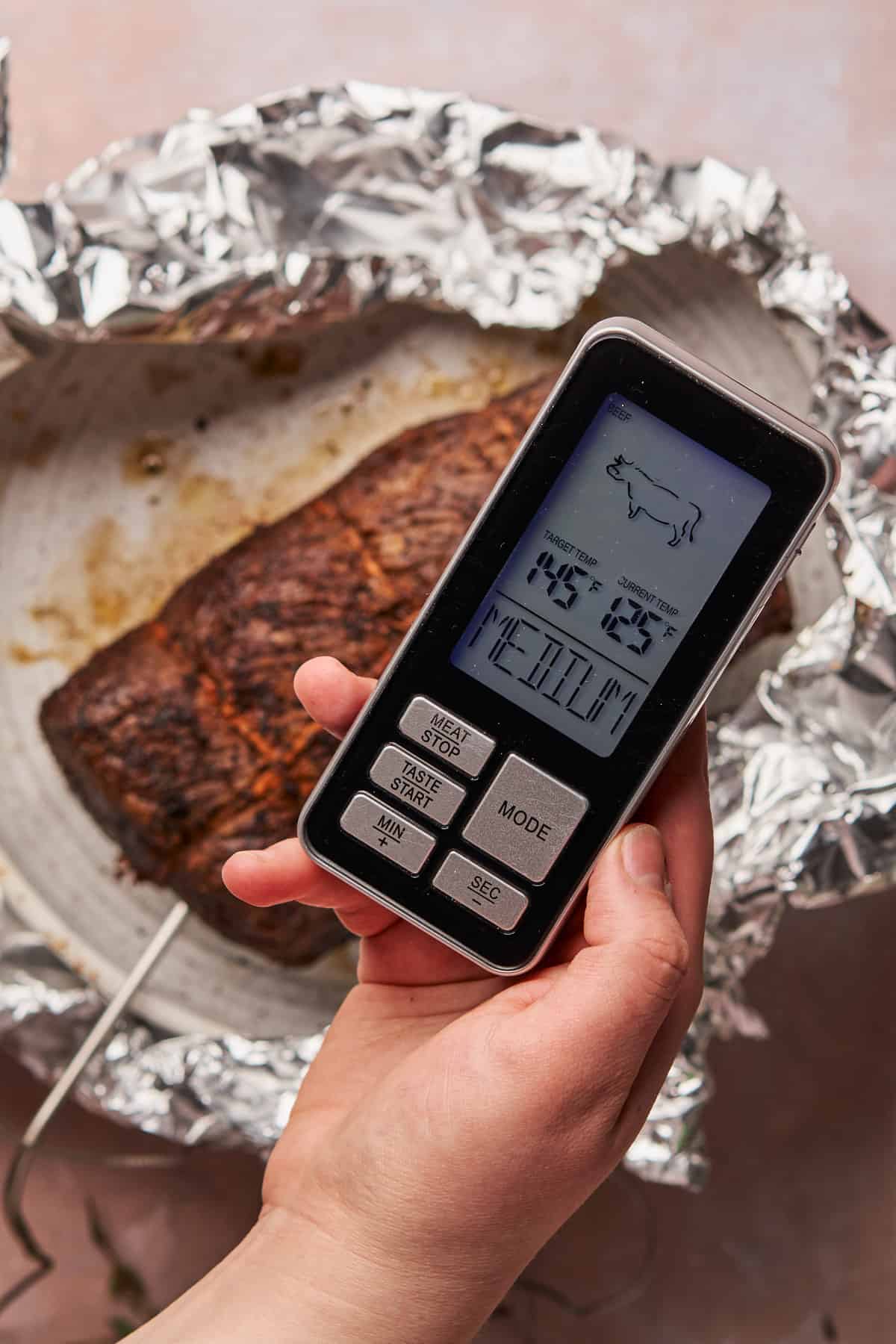
Make the gravy
Meanwhile, while the roast is resting, prepare the gravy. Remove the bay leaves, garlic cloves, and thyme from the pan and discard. Add the remaining beef stock, butter, and heavy cream, and allow the sauce to simmer over low heat, stirring to scrape any browned bits from the bottom of the pan.
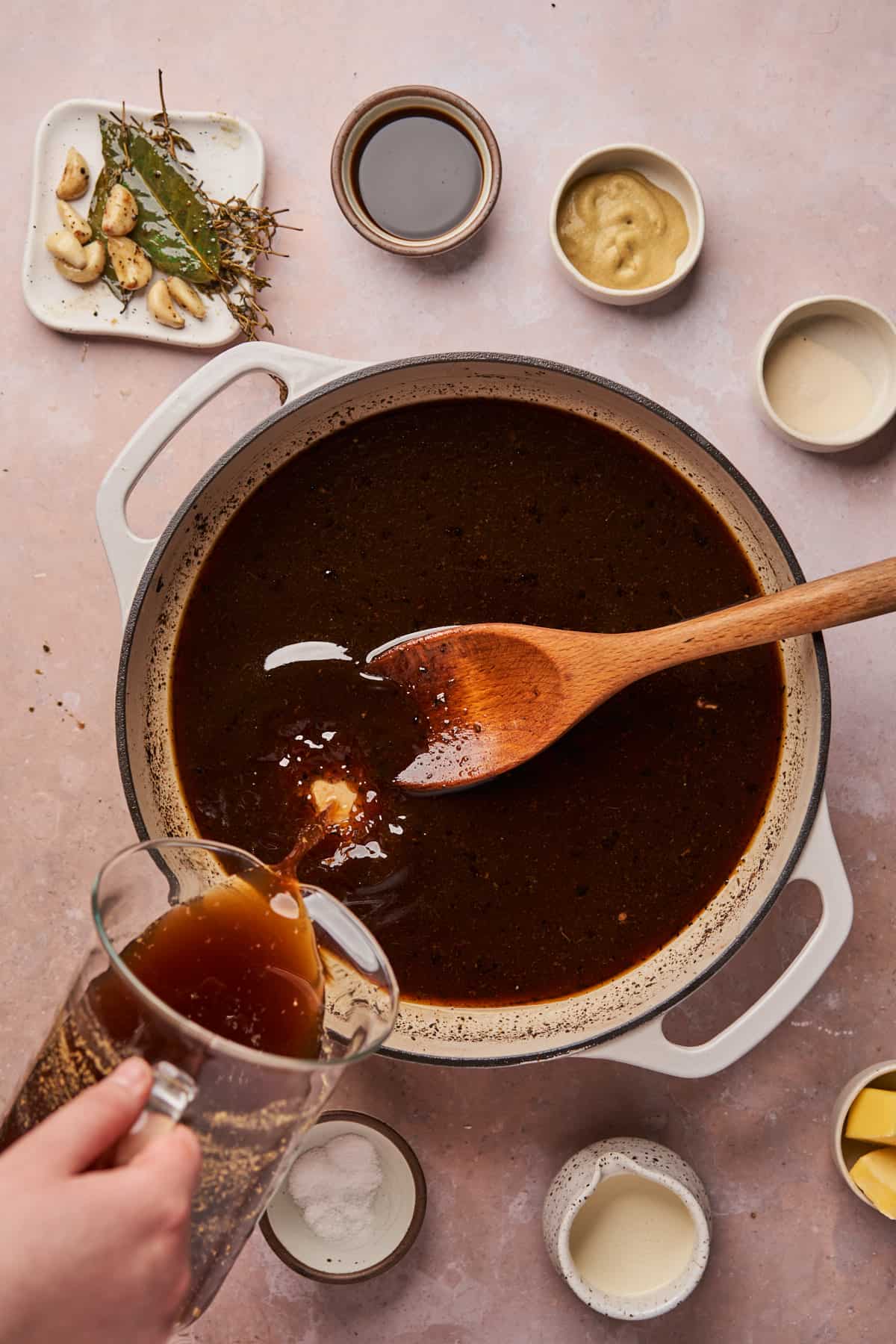
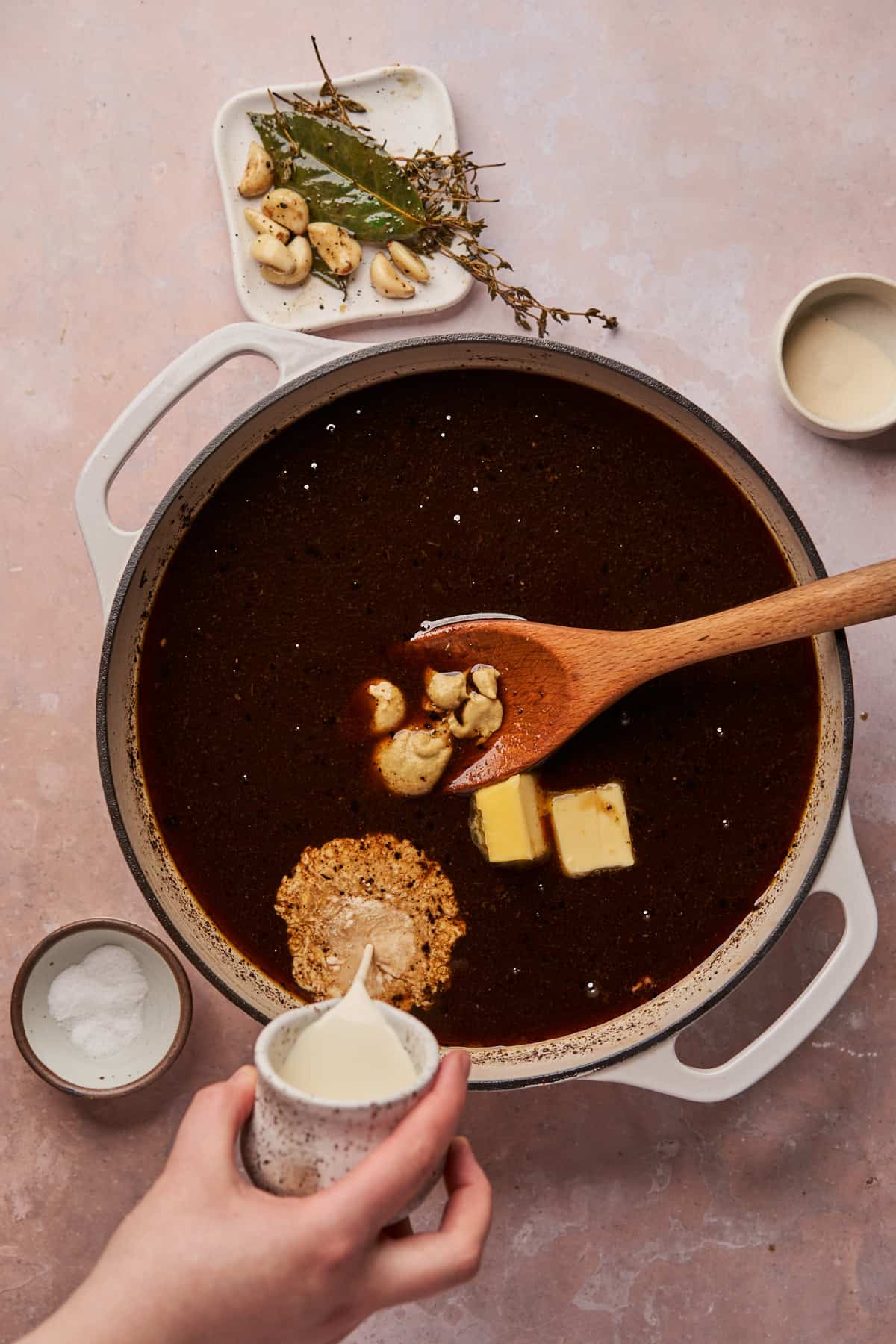

Whisk in the Worcestershire sauce and dijon mustard. Sprinkle in xanthan gum slowly to thicken the sauce, simmer for 10-15 minutes. Make sure to not let the gravy boil, as this will curdle the cream. Adjust seasonings to taste. You will know you're ready when the gravy coats the back of a spoon.
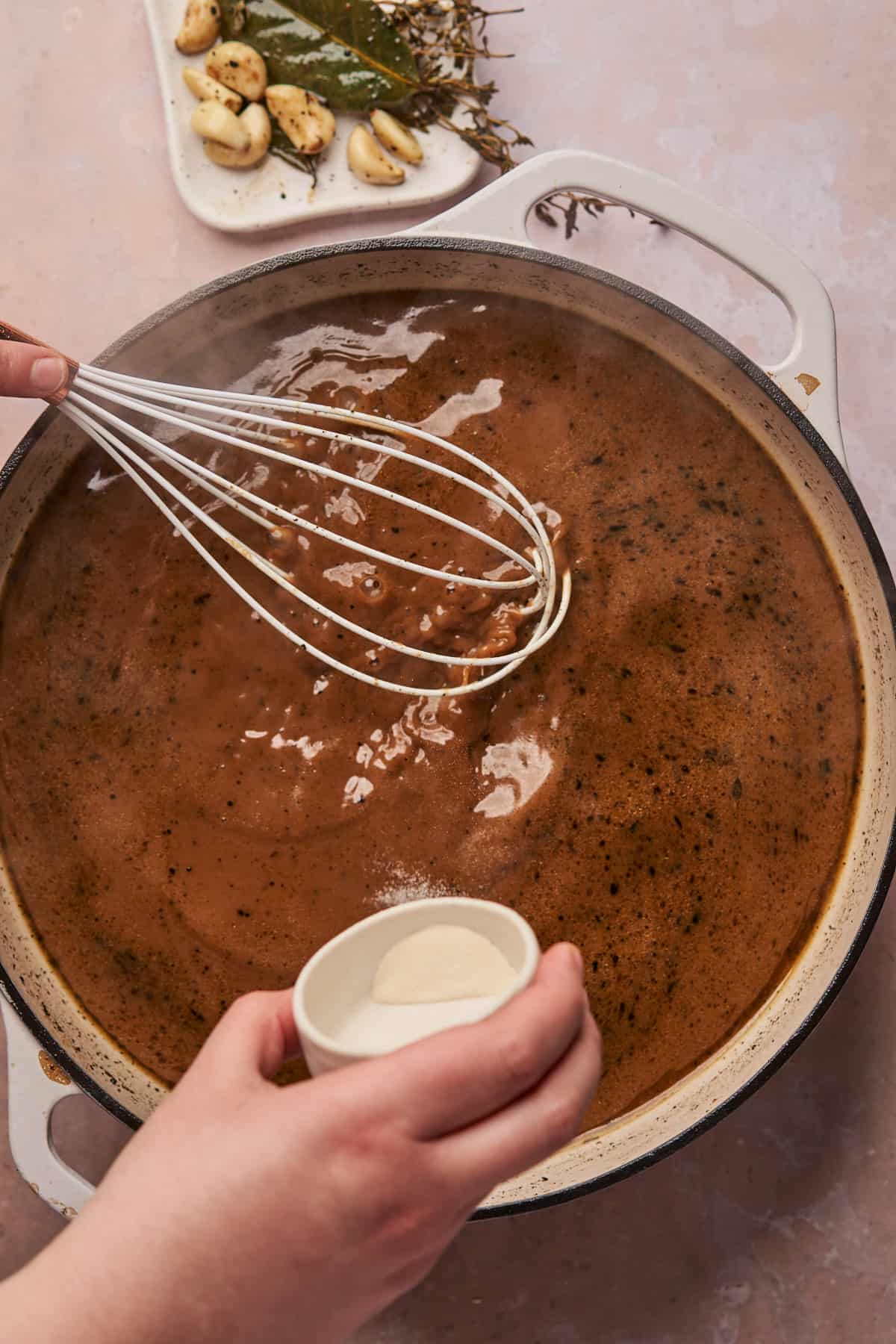
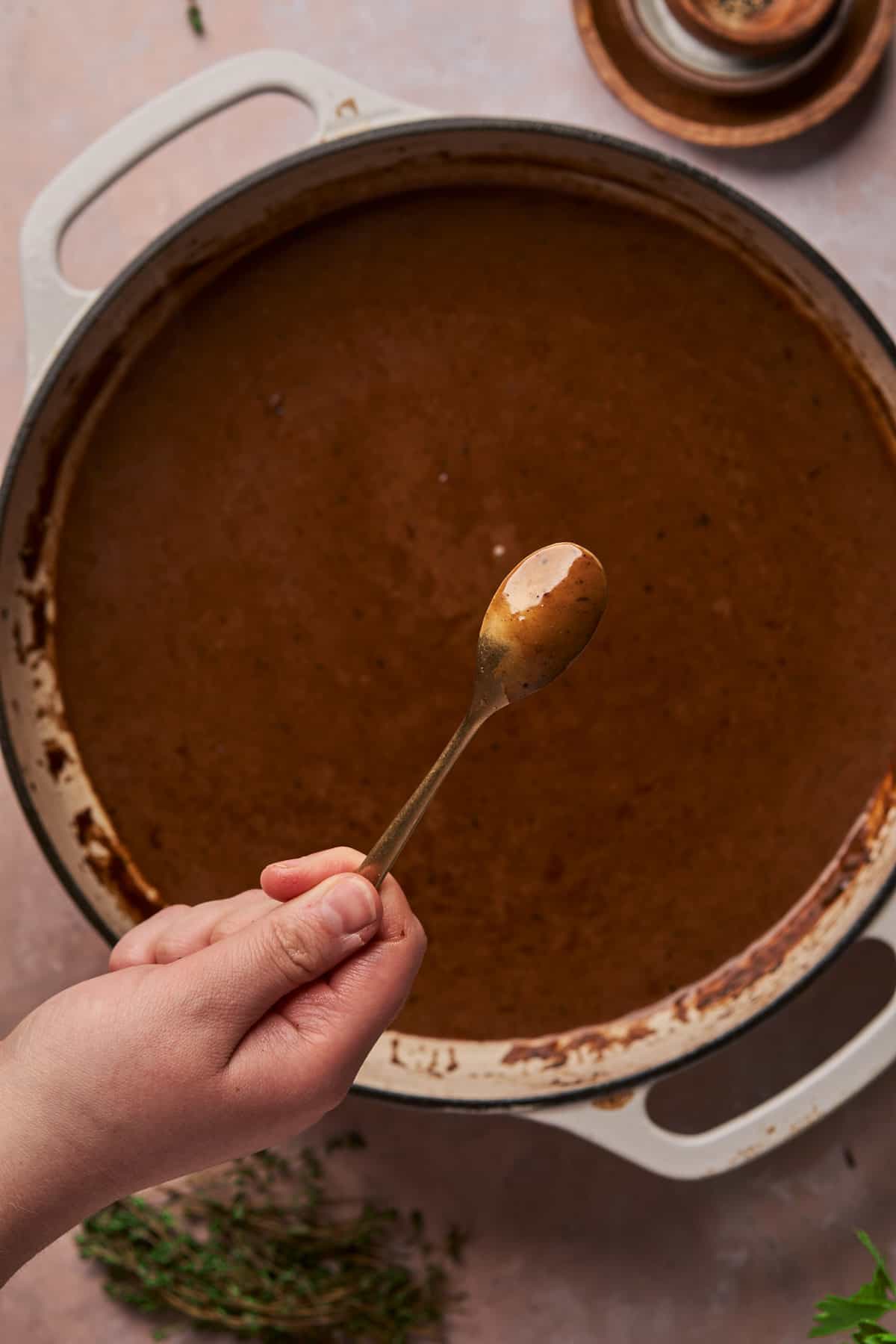
Now, it's time to cut the beef into thin pieces, serve with your favorite sides, and douse with gravy. Enjoy!!
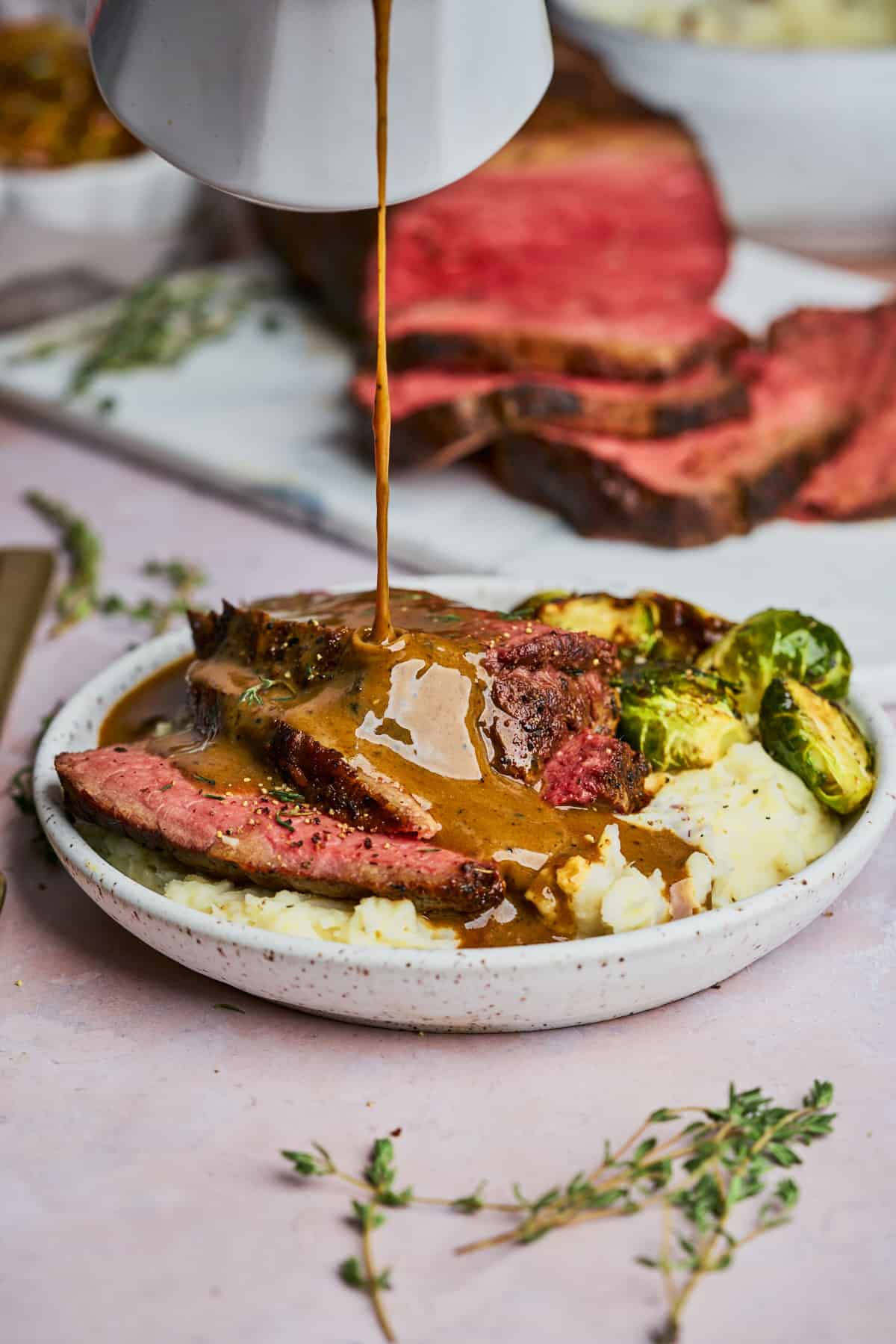
✨Tips & tricks
Here are our top tips for how to cook melt in the mouth roast beef. If you follow our suggestions, you can't miss!
- Don't overcook the beef. Roast beef is meant to be served rare to medium-rare. We don't recommend cooking the meat beyond medium-rare, or the meat will become dried out, tough, and less flavorful.
- Do not undercook the beef either. Undercooking the meat can also be a problem, as roast beef needs to cook for a while to become flavorful and tender. If you undercook the beef, not only is this potentially unsafe, but it will also be a little tough or chewy.
- Use a meat thermometer. We know this may not be something you want to hear, but oven-safe thermometers are the key to making sure your dishes come out perfectly every time!
- Take the meat out about 5-8°F before it has reached its target temperature. Smaller roasts will probably only increase about 5-6°F after cooking when tented and resting, so keep this in mind if your roast is under 4 pounds. If you cook the roast all the way to it's target temperature, it will continue to cook for awhile outside of the oven, and therefore will become overcooked when it's time to eat.
- Cook low and slow. We don't recommend trying to speed up this process with a higher oven temperature. As we've mentioned, this will dry the roast out.
- Don't skip searing. Searing the outside helps lock in flavor and juices, as well as creates a flavorful brown gravy, as some of the brown bits stay in the pan and get deglazed later.
- Don't skip the braising liquid. This helps infuse both the roast and what will become the gravy with loads of flavor. Plus, the braising liquid helps keep the beef nice and moist while it cooks.
- Don't skip tenting the meat & resting. We know it can be tempting to dig right in, but you want to lock in all of the flavor and juices of the roast beef, as well as allow the beef to continue cooking. Resting and tenting the meat with aluminum foil is crucial to a juicy and tender roast beef.
- Season the roast heavily. Don't be shy! You want to make sure to use a lot of seasoning, since roasts are very thick cuts of meat. You want to infuse as much flavor as you can into the roast.

💭Frequently asked questions
How much roast beef should I have per person?
About ½ a pound, or 8 ounces is a good rule of thumb for meat per person. For those with big appetites, you may want about ¾ a pound or 12 ounces per person.
Can I sear the roast with a string on?
Yes, assuming that is cotton or safe to withstand heat. The string is meant to keep the roast in place so it's easier to carve later on for a better presentation, so we recommend keeping it on.
If the roast comes in a plastic netting, you should not sear the meat with it on, but be aware, that the roast may fall apart.
What are the best cuts of meat to use for oven roast beef?
Some popular cuts include bottom round roast (like we used), rump roast, top round roast, eye of round roast, boneless chuck roast, sirloin tip roast, and more.
Keep in mind that these tougher cuts of meat will need to cook at a low temperature for a long period of time in order to be juicy. No one likes overcooked roast beef!
A good general rule of thumb for a large cut of beef is the slow method. In other words, the best way to cook cheaper cuts of meat is low and slow. This is the same method we would use when making a pot roast.
You can also use more premium cuts of meat like beef tenderloin, or ribeye roast, also known as prime rib, which is popular during the holidays. These cuts will be supremely tender when cooked properly.
✨Substitutions
If you follow a different diet type, don't worry! We have a few suggestions.
- Worcestershire sauce - This can be swapped for soy sauce.
- Red wine - If you don't drink or cook with wine, feel free to swap it for beef broth or stock 1:1.
- Xanthan gum - Is our favorite gluten free thickener, and we always use it to thicken our gravies, as well as help bind together many of our baked goods. You can also use all-purpose flour for a more traditional thickener. More gluten free options include cornstarch and arrowroot powder.
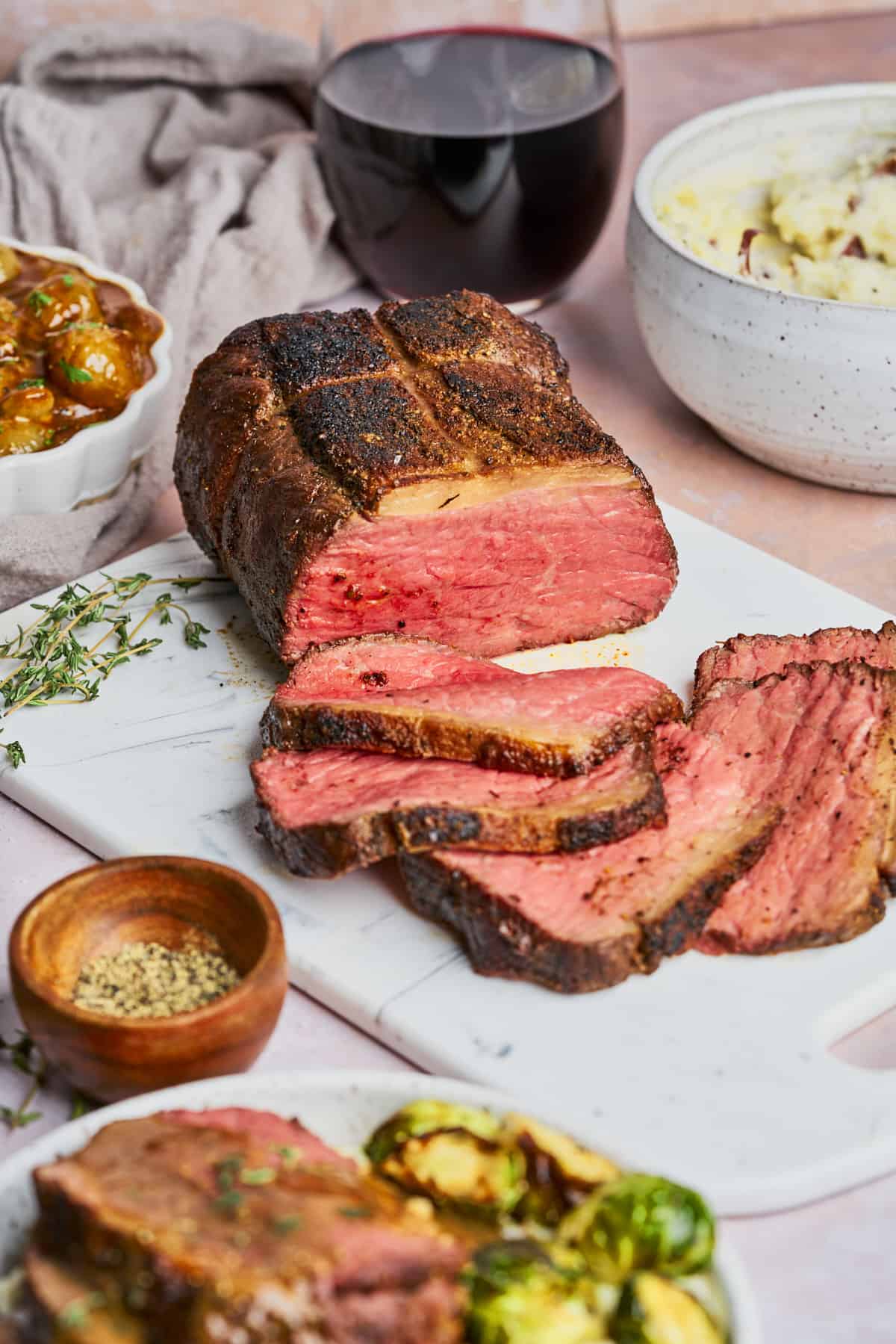
🥔What to serve with roast beef
Roast beef can be accompanied by a variety of sides, here are some of our favorites!
- Maple glazed carrots
- Redskin mashed potatoes
- Smashed potatoes with garlic and herbs or fingerling potatoes
- Bacon wrapped asparagus bundles
- Creamy mashed turnips
- Roasted balsamic and bacon brussel sprouts
- Creamed pearl onions
♨️temperature guide
Please note, that we can't guarantee cook times when reaching these temperatures. It may take less time with a smaller roast, or more time with a larger roast, which is why we suggest using a meat thermometer. As mentioned, these are target internal temperatures, and the beef roast should be taken out of the oven 5-8°F before the target temperature is reached.
- Rare - 120°F - The center of the roast will be cool to warm, very tender, and a red to pink color.
- Medium rare - 130°F - This is generally considered the "perfect cook" on most cuts of beef. The center will be red and warm.
- Medium - 140°F- This cook will have a hot pink center, and the roast will be slightly firmer in texture. We find this to be a little over cooked.
- Medium-well - 150°F- The roast will be mostly brown and firm in the center.
- Well done - 160°F+ - Finally, this cook will have absolutely no pink color in the center. It will be completely brown, firm, and very dry. We don't recommend cooking your roast to this temperature.
🛒Shop this post
Want more supplies for this recipe or to shop our kitchen or pantry? We've linked our favorites right here in our Amazon Store!
A Full Living is a participant in the Amazon Services LLC Associate program, an affiliate advertising program designed to promote a means for sites to earn advertising fees by linking products to amazon.com. We only share products we use and love. It doesn't cost you anything extra to shop using our links, but we earn a small commission that helps us keep this site going!
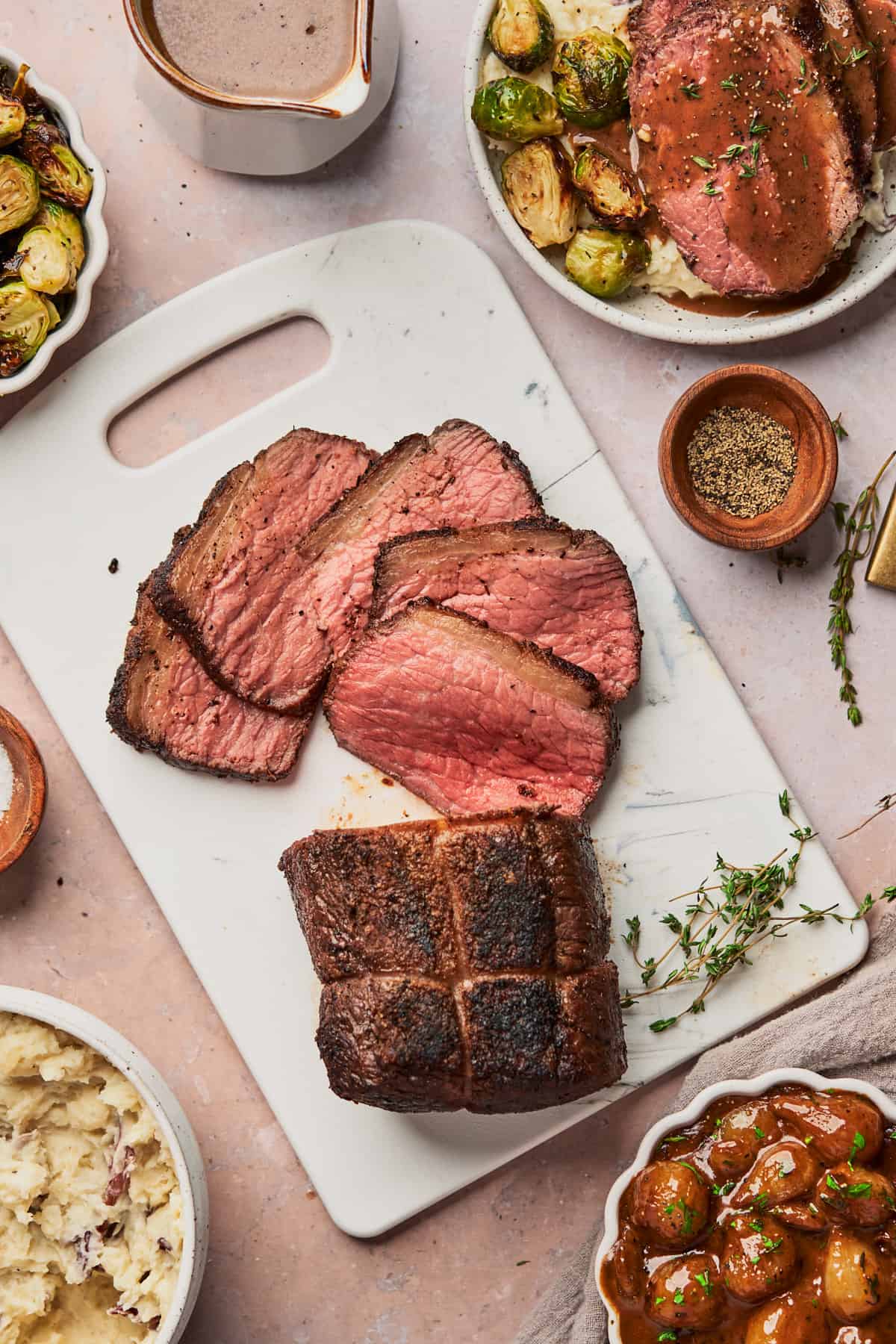
🥣Storage & reheating
Store leftovers in an airtight container in the fridge for up to 4 days.
To reheat in the oven: wrap the leftover roast in foil, then reheat gently in a 250°F oven until the internal temperature reaches about 120-125°F. This can take some time, anywhere from 30 minutes to 1 hour depending on how much beef is left. This helps to keep the beef juicy.
You can also reheat gently in the air fryer, on the stovetop, or in the microwave, but these will cook the meat faster and potentially dry it out, so be careful.
🌟Leave a review!
Make sure to leave a 5-star review below! This helps other readers find our recipes via Google, and encourages them to try them. Also be sure to leave a comment with your experience!
Take a photo and share with us by tagging us on Instagram or follow along on Pinterest for more ideas!
📖 Recipe
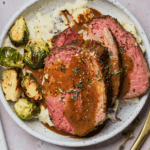
For the beef roast:
- 3 pounds bottom round beef roast (or your cut of choice)
- 1.5 tablespoons kosher salt, divided (to taste)
- 1.5 teaspoons coarse black pepper, divided (to taste)
- ½ teaspoon garlic powder
- ½ teaspoon onion powder
- ½ teaspoon dried thyme
- ½ teaspoon smoked paprika
- 2 tablespoons olive oil
For the braising liquid & gravy:
- 32 ounces beef stock, divided (4 cups)
- 4 ounces dry red wine (can be replaced with more beef stock)
- 8 cloves garlic
- 8 sprigs fresh thyme (optional)
- 2 bay leaves
- 2 tablespoons Worcestershire sauce
- 1 tablespoon dijon mustard
- 2 tablespoons unsalted butter
- 2 ounces heavy cream
- ½ teaspoon xanthan gum (to thicken the gravy)
-
Preheat the oven to 250°F. In a small bowl, combine most of the salt, and pepper. Then add in all the garlic powder, onion powder, smoked paprika, and thyme. Season the roast really well on all sides. Reserve a bit of salt and pepper for later.
-
Heat a skillet or dutch oven over medium high heat. Add the olive oil, and sear roast on all sides until brown. This will take roughly 10 minutes, then transfer meat to a plate.
-
To the skillet, add about half (2 cups) of beef broth and red wine and scrape the bottom of the pan with a wooden spoon. Add the beef roast back to the pan, then add in thyme, garlic cloves, and bay leaves. Add to the oven, uncovered, and cook using a meat thermometer until the temperature reaches around 115 - 120°F to enjoy the roast medium-rare.
-
Remove the roast from the pan, set it on a plate, and tent the roast with foil. Leave the thermometer inside to monitor the temperature. Allow the roast to rest tented for at least 15-20 minutes, and allow the temperature to reach 125°F - 130°F depending on your preferences. Don't skip this step.
-
Meanwhile, prepare the gravy. Remove the bay leaves, garlic cloves, and thyme from the pan and discard. Add the remaining beef stock, and allow the sauce to simmer over low heat. Add in the butter, and the heavy cream, and then whisk in the Worcestershire sauce and dijon mustard. Sprinkle in xanthan gum slowly to thicken the sauce, simmer for 10-15 minutes. Don't allow the sauce to boil or you will curdle the cream. Adjust seasonings, and when the gravy coats the back of a spoon, you're ready. Cut the beef thin, and serve with gravy and sides of choice. Enjoy!
-
Store in the fridge in an airtight container for up to 4 days. Reheat gently.
- Always use a meat thermometer to ensure the proper internal temperature is reached. Undercooking or overcooking your meat will result in tough or dry meat.
- Take the meat out and tent it about 5-8°F before the target temperature is reached depending on the size of the roast. Larger roasts will come up in temperature more than smaller roasts.
- Don't skip searing, tenting, and resting the meat, which allows for the temperature to come up properly, as well as seal in the juices and creates flavor.
- Please view extensive notes and details in the body of the post.
Sodium: 2283 mg | Calcium: 89 mg | Vitamin C: 4 mg | Vitamin A: 416 IU | Sugar: 2 g | Fiber: 1 g | Potassium: 1154 mg | Cholesterol: 161 mg | Calories: 477 kcal | Trans Fat: 1 g | Monounsaturated Fat: 10 g | Polyunsaturated Fat: 1 g | Saturated Fat: 9 g | Fat: 23 g | Protein: 54 g | Carbohydrates: 6 g | Iron: 6 mg
These nutrition facts are provided as a courtesy and are only estimates. We cannot guarantee the accuracy.
If you made this recipe, make sure to show us on Instagram at @AFullLiving or tag #AFullLiving! We love to see what you guys are making!
Source: https://afullliving.com/how-to-cook-melt-in-the-mouth-roast-beef-with-gravy/
0 Response to "How Too Cook Melt in Your Mouth Beef Roast"
Post a Comment